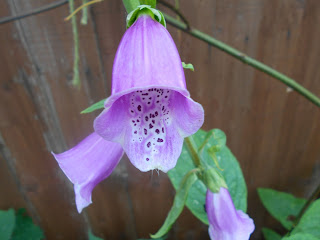It is, of course, poisonous, the seeds especially so (although the drug used medically is extracted from the leaves), and one of its old country names is Dead Man's Bells. I have grown several species over the years and one of them, Digitalis lutea, seeded so freely in Byfield that it almost attained the status of a weed. I now confine myself to our native foxglove, not only because it is arguably the loveliest of them all, but it is a very good bee-plant too.
 |
Digitalis purpurea in our garden in Daventry, showing the
freckles on the lower part of the corolla tube. 10 June, 2016
|
Here in Northamptonshire it is very local as a truly wild plant, being another of those species referred to by G. Claridge Druce in his 1930 flora of the county as rare and ericetal, i.e growing - like Erica (heather) - in acid soils (it flourishes at the summit of Borough Hill, here in Daventry). Gardeners have learned however that, given otherwise good care, it will tolerate a little lime. Indeed it is now frequent on waste ground around villages as a garden escape.
I was surprised, given the dearth of acid soils in the east of Northants, that John Clare mentions it:
Though the thickets bushy dell
Tempts me to the Foxglove's bell.
Clare's Village Minstrel, 1821
 |
| A neighbouring plant with the corolla approaching white |
At least three poisonous elements are found in the plant and it needs to be used with great care, but my old 'Potter's Cyclopaedia of Botanical Drugs' recommends its use as a cardiac tonic, sedative and diuretic. Hmmm.
It is grown is gardens as a biennial, but I find that, if cut back after flowering, it will persist for three or four years. Seedlings germinate easily and give flowers ranging from the usual purple through to an almost pure white.
Given the poisonous nature of the plant it is interesting to note that several insects feed on it, including the bug, Dicyphus pallicornis. The Foxglove Pug, Eupithecia pulchellata is a not uncommon moth and this August I'll be looking for its green or brown caterpillars.
Given the poisonous nature of the plant it is interesting to note that several insects feed on it, including the bug, Dicyphus pallicornis. The Foxglove Pug, Eupithecia pulchellata is a not uncommon moth and this August I'll be looking for its green or brown caterpillars.
No comments:
Post a Comment